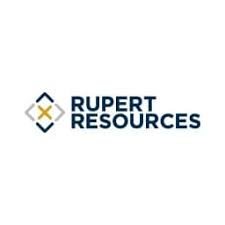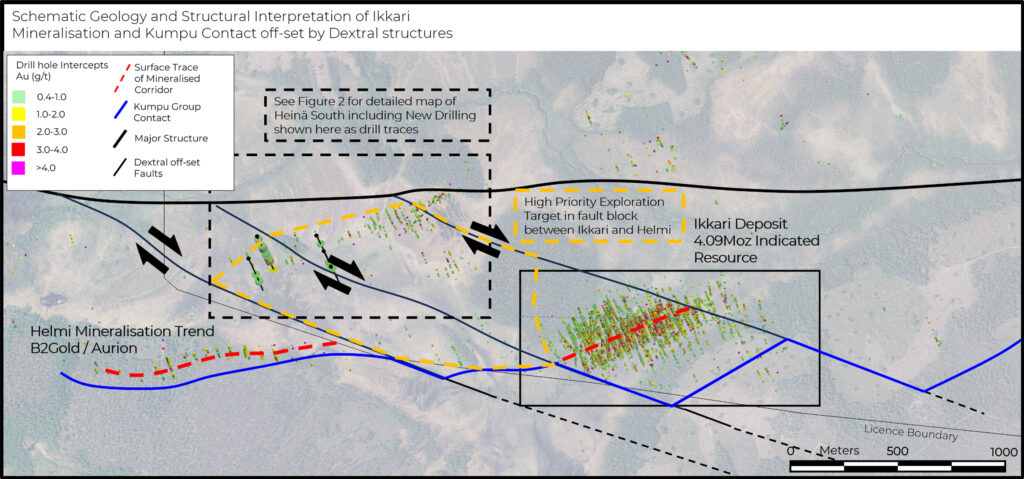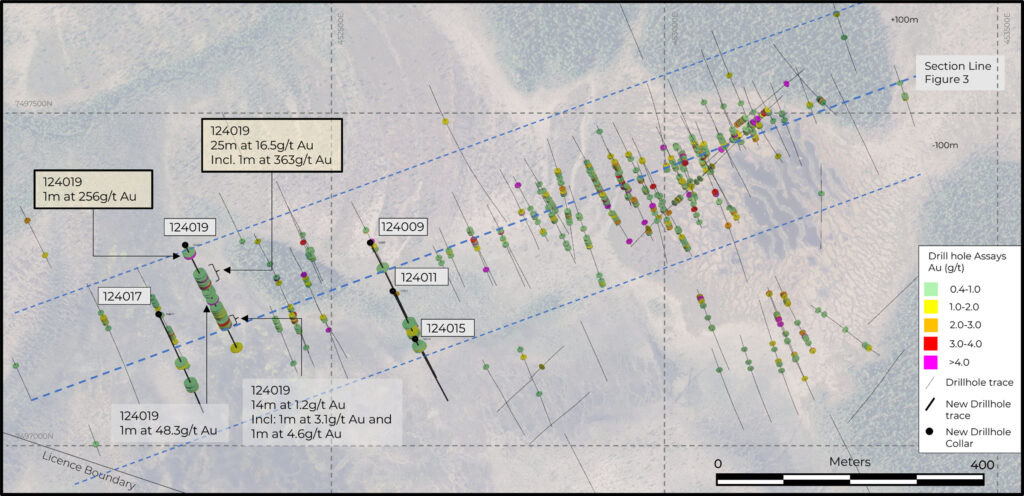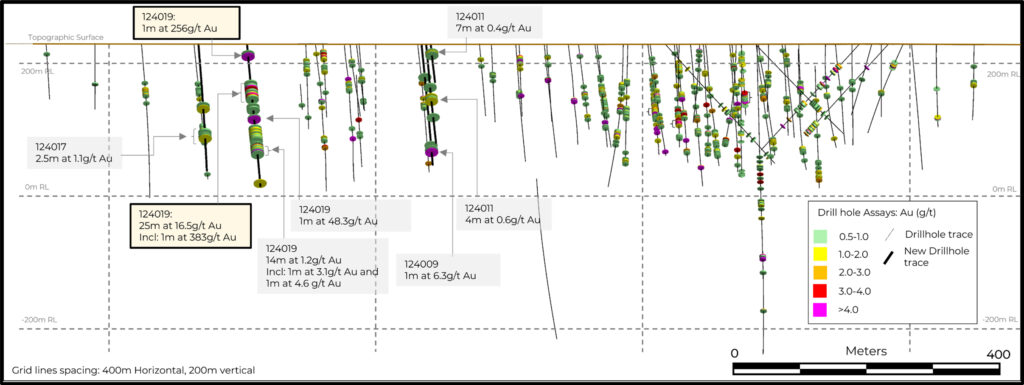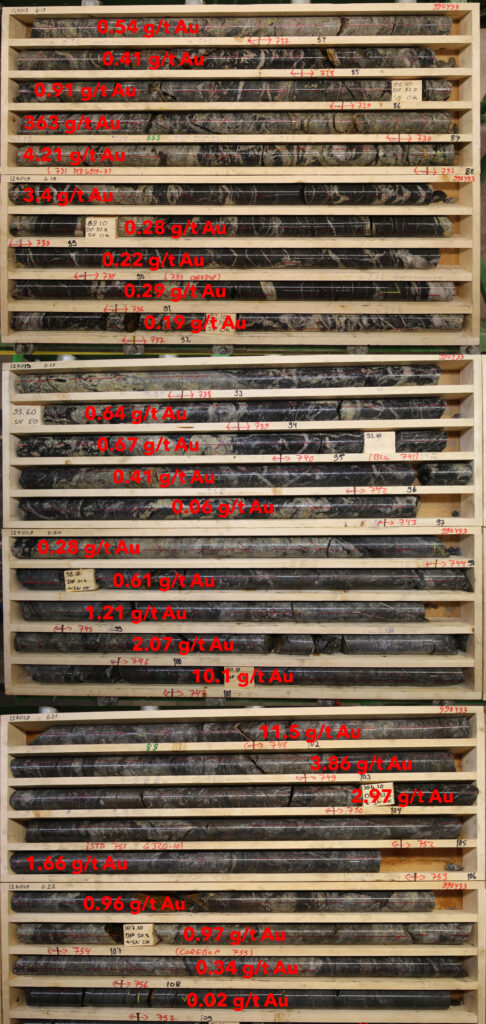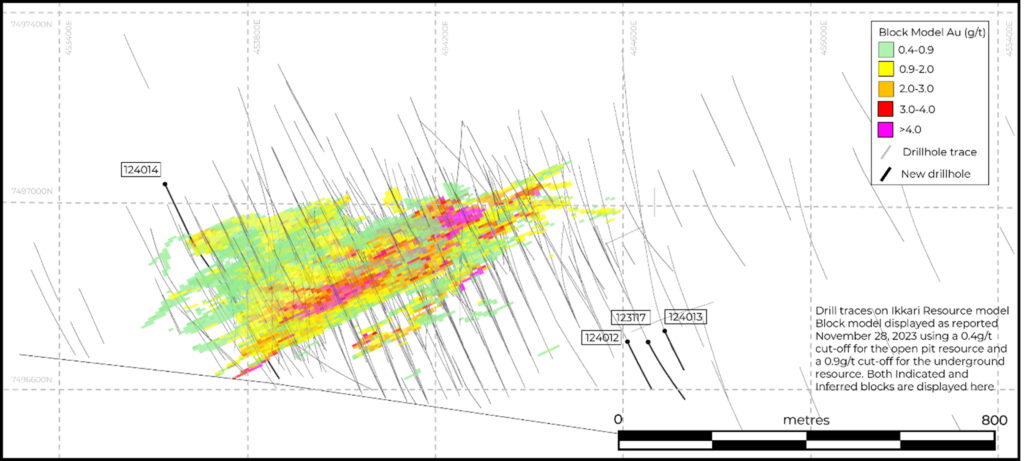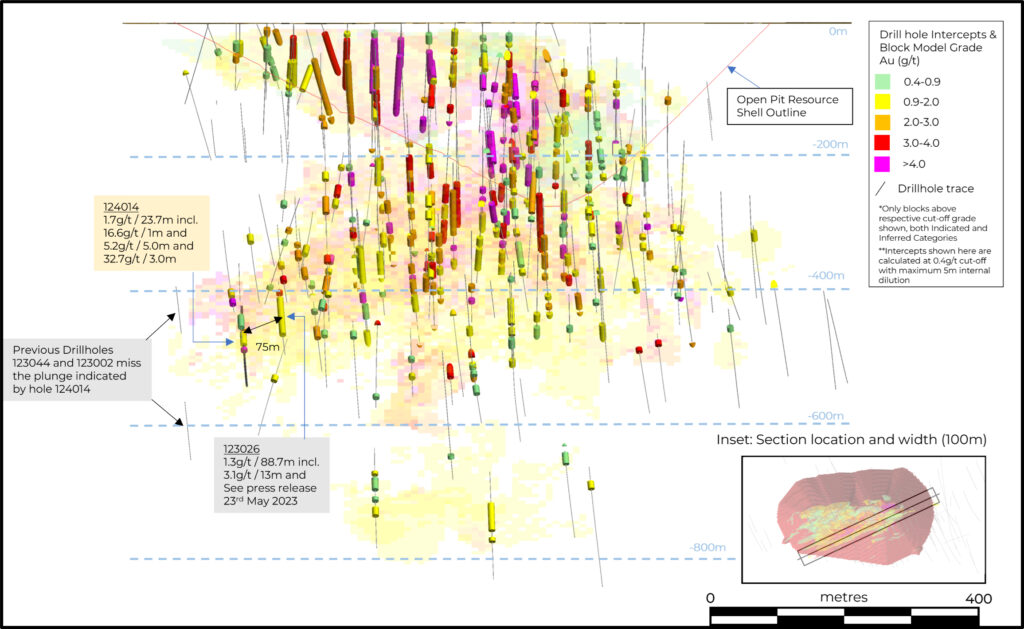
Rupert Resources Reports New Results From Winter Drilling Campaign Including 16G/T Over 25M at Heinä South and Extension to Mineralisation at Ikkari
Rupert Resources Ltd. reports follow-up assay results from its Heinä South satellite target (located 1km from Ikkari). The results confirm evidence of broader mineralised zones than previously seen at Heinä South. New assays are also published from drilling at Ikkari demonstrating that mineralisation remains open down plunge to the west with both wide and high-grade intercepts achieved.
Highlights
- #124019 – intersected 25m at 16.5 g/t Au from 83m including 1m at 363g/t Au and 2m at 10.8g/t Au. The hole also intersected multiple other intercepts including 1m at 256g/t Au from 25m, 1m at 48.3g/t Au from 146m and 14m at 1.2g/t Au from 201m. Drilling continues and results from seven further drill holes in Heinä South are pending.
- #124014 tested extensions of mineralisation along the shallow plunge at depth in the west of Ikkari. The drillhole yielded multiple intercepts including both wider intercepts (23.70m at 1.7g/t Au from 602m, including 1m at 16.6g/t Au) and higher-grade intercepts (5m at 5.2g/t Au from 633m, including 1m at 19.8g/t Au and 3m at 32.7g/t Au from 655m, including 1m at 93.8g/t Au) in the target area demonstrating that mineralisation at Ikkari remains open to the west at depth.
James Withall, CEO of Rupert Resources commented “The initial results from #124019 are confirmation of more continuous mineralisation at Heinä South which, along with extensional drilling at Ikkari, remains the current focus of our winter drilling campaign. During this drilling season we will continue to test a number of the targets at shallow depths which have the potential to become satellite deposits to the 4Moz1 Ikkari deposit alongside the works to advance project engineering and permitting.”
Heinä South
Ongoing drilling at Heinä South target continues to identify a broader style of mineralisation at the target than was in evidence from drilling undertaken in previous years. #124019, reported today, returned 25.0m at 16.5g/t Au including 1.0m at 363g/t Au with wider mineralised intervals hosted in sulphide rich breccia units. #124019 is an 80m step-out to the east from previously reported #124001 (24.5m at 1.1g/t Au). The high-grade potential of the Heinä South target area is further evidenced by the high-grade intercept of 558g/t Au over 2m in 124006, located a further 250m to the east, see press release dated 8th of February 2024). Drilling has now confirmed a strike of more than 1000m at Heinä South with mineralisation across a 200m wide corridor. Current drilling is focussed on the previously sparsely tested western strike extent where mineralisation is distinct from that further to the east and greater widths of mineralisation are encountered.
Ikkari extension
#124014 is the first hole to be reported from Ikkari from the winter 2023/24 program. results show multiple mineralised intercepts with the main target area yielding both wider (23.70m at 1.7g/t Au from 602m, including 1m at 16.6g/t Au) and higher grade (5m at 5.2g/t Au from 633m, including 1m at 19.8g/t Au and 3m at 32.7g/t Au from 655m, including 1m at 93.8g/t Au) intercepts. These intercepts provide further evidence for the shallow western plunge interpreted in this portion of the deposit where mineralisation remains open to the west. The intercepts from #124014 represent a 75m step-out along plunge from previously released #123026, 88.70m at 1.3g/t Au from 487.30m including 13m at 3.1g/t Au from 495m (see release dated May, 23 2023) that was included in the November 2023 MRE for Ikkari.
Geological interpretation of Ikkari
Ikkari was discovered using systematic regional exploration that initially focused on geochemical sampling of the bedrock/till interface through glacial till deposits of 5m to 40m thickness. No outcrop is present, and topography is dominated by low-lying swamp areas.
The Ikkari deposit occurs within rocks that have been regionally mapped as 2.05-2.15 billion years old Savukoski group greenschist-metamorphosed mafic-ultramafic volcanic rocks, part of the Central Lapland Greenstone Belt. Gold mineralisation is largely confined to the structurally modified unconformity at a significant domain boundary. Younger sedimentary lithologies are complexly interleaved, with intensely altered ultramafic rocks, and the mineralized zone is bounded to the north by a steeply N-dipping cataclastic zone. Within the mineralised zone lithologies, alteration and structure appear to be sub-vertical in contrast to wider Area 1 where lithologies generally dipping at a moderated angle to the north.
The main mineralized zone is strongly altered and characterised by intense veining and foliation that pervasively overprints original textures. An early phase of finely laminated grey ankerite/dolomite veins is overprinted by stockwork-like irregular siderite ± quartz ± chlorite ± sulphide veins. These vein arrays are often deformed with shear-related boudinage and in situ brecciation. Magnetite and/or haematite are common, in association with pyrite. Hydrothermal alteration commonly comprises quartz-dolomite-chlorite-magnetite (±haematite). Gold is hosted by disseminated and vein-related pyrite. Multi-phase breccias are well developed within the mineralised zone, with early silicified cataclastic phases overprinted by late, carbonate- iron-oxide- rich, hydrothermal breccias which display a subvertical control. All breccias frequently host disseminated pyrite, and are often associated with higher gold grades, particularly where magnetite or haematite is prevalent. In the sedimentary lithologies, albite alteration is intense and pervasive, with pyrite-magnetite (± gold) hosted in veinlets in brittle fracture zones.
Geological interpretation of Heinä South
The Heina South target was reappraised based on results from a new higher resolution geophysical survey flown in later 2023 which identified a south-west extension which had been untested in previous years due to a lack of base of till anomalism. Gold mineralisation in the west of Heinä South is associated with multi-phase sulphide mineralisation consisting of pyrite+-pyrrhotite+-chalcopyrite, principally occurring as the matrix to an earlier brecciated (iron)-carbonate phase. The earlier veins occur primarily within altered carbonaceous sediments folded between more homogenous gabbroic units. Gold mineralisation in the east of Heinä South is hosted within quartz-pyrite and massive pyrite veins and as lenses, as part of a stockwork of quartz-carbonate veins. Zones of massive pyrite contain the highest grades (>10g/t Au) with disseminated sulphide zone containing anomalous (<0.5g/t) gold. Early quartz-carbonate veins are overprinted by extensional veins that include coarse-grained pyrite and form sub-parallel trends, broadly related to lithological contacts between sediments and mafic-intermediate intrusives, although mineralisation also occurs within both lithologies. Further drilling is required to allow a resource to be published for the occurrence.
Review by Qualified Person, Quality Control and Reports
Craig Hartshorne, a Chartered Geologist and a Fellow of the Geological Society of London, is the Qualified Person, as defined by National Instrument 43-101, responsible for the accuracy of scientific and technical information in this news release.
The majority of samples are prepared by ALS Finland in either Sodankylä or Outokumpu. Fire assays are subsequently completed at ALS Romania whilst multielement analysis is completed in ALS Ireland or Sweden. A minority of samples are prepared by Eurofins Laboratory in Sodankylä and Fire Assay is carried out on site. A pulverised sub-sample is then sent to ALS Ireland for multi-element analysis. All samples are under watch from the drill site to the storage facility. Samples at both laboratories are assayed using 50g fire assay method with aqua regia digest and analysis by AAS for gold. Over limit analysis (>100 ppm Au) are conducted using fire assay and gravimetric finish. For multi-element assays, Ultra Trace Level Method by 4-Acid digest (HF-HNO3-HClO4 acid digestion, HCl leach) and a combination of ICP-MS and ICP-AES are used. The Company’s QA/QC program includes the regular insertion of blanks and standards into the sample shipments, as well as instructions for duplication. Standards, blanks and duplicates are inserted at appropriate intervals. Approximately five percent (5%) of samples have the pulp reject resubmitted for check assaying at a second laboratory.
Results presented for Hole 124019 include results from screen fire assay as indicted in Table 2. Screen fire assays were requested due to the presence of coarse gold in the drill core and were performed by ALS Romania. Screen fire assays involve the screening of 1kg at 106 microns to separate the sample into a coarse fraction (>106μm) and a fine fraction (<106μm). After screening, two 50g sub-samples of the fine fraction are analysed using the normal 50g fire assay method with aqua regia digest and analysis by AAS for gold. The entire coarse fraction is assayed to determine the contribution of the coarse gold using fire assay and gravimetric finish. The “total” gold calculation for the 1kg sample is based on the weighted average of the coarse and fine fractions and is reported for the indicated samples.
Base of till samples are prepared in ALS Sodankylä by dry-sieving method prep-41 and assayed for gold by fire assay with ICP-AES finish. Multi-elements are assayed in ALS laboratories in either of Ireland, Romania or Sweden by aqua regia with ICP-MS finish. Rupert maintains a strict chain of custody procedure to manage the handling of all samples. The Company’s QA/QC program includes the regular insertion of blanks and standards into the sample shipments, as well as instructions for duplication and external check assays.
About Rupert Resources
Rupert Resources is a gold exploration and development company listed on the TSX Exchange under the symbol “RUP.” The Company is focused on making and advancing discoveries of scale and quality with high margin and low environmental impact potential. The Company’s principal focus is Ikkari1, a new high quality gold discovery in Northern Finland. Ikkari is part of the Company’s “Rupert Lapland Project,” which also includes the Pahtavaara gold mine, mill, and exploration permits.
APPENDIX
Table 1. Collar locations of new drill holes, Heinä South
| Hole ID | Prospect | Easting | Northing | Elevation | Azimuth | Dip | EOH (m) |
| 124009 | Heinä South | 452559.2 | 7497304.2 | 226.5 | 152.8 | -50.7 | 242.20 |
| 124011 | Heinä South | 452593.2 | 7497231.4 | 226.6 | 153.7 | -50.4 | 223.90 |
| 124015 | Heinä South | 452626.8 | 7497159.3 | 226.6 | 153.3 | -50.8 | 164.00 |
| 124017 | Heinä South | 452241.4 | 7497197.7 | 226.8 | 154.4 | -50.1 | 250.50 |
| 124019 | Heinä South | 452281.3 | 7497301.7 | 226.7 | 153.8 | -50.5 | 277.30 |
Table 2. New Intercepts from Heinä South
| Hole ID | From
(m) |
To
(m) |
Interval
(m) |
Grade Au
(g/t) |
|
| 124009 | 65.00 | 66.00 | 1.00 | 0.7 | |
| 202.00 | 203.00 | 1.00 | 0.6 | ||
| 211.00 | 212.00 | 1.00 | 0.5 | ||
| 216.00 | 217.00 | 1.00 | 6.3 | ||
| 124011 | 83.50 | 84.00 | 0.50 | 0.8 | |
| 85.00 | 86.00 | 1.00 | 0.5 | ||
| 104.00 | 105.00 | 1.00 | 1.0 | ||
| 109.00 | 113.00 | 4.00 | 0.7 | ||
| 144.00 | 145.00 | 1.00 | 0.9 | ||
| 124015 | 16.00 | 23.00 | 7.00 | 0.4 | |
| including | 19.00 | 20.00 | 1.00 | 1.6 | |
| 124017 | 122.00 | 123.00 | 1.00 | 0.9 | |
| 128.00 | 129.00 | 1.00 | 1.2 | ||
| 174.00 | 177.00 | 3.00 | 0.6 | ||
| 182.00 | 183.00 | 1.00 | 0.4 | ||
| 185.00 | 187.50 | 2.50 | 0.9 | ||
| 124019 | 19.00 | 20.00 | 1.00 | 0.4 | |
| 24.00 | 25.00 | 1.00 | 2561 | ||
| 76.00 | 78.00 | 2.00 | 0.5 | ||
| 83.00 | 108.00 | 25.00 | 16.512 | ||
| including | 86.00 | 87.00 | 1.00 | 3631 | |
| and | 99.00 | 106.00 | 7.00 | 4.81 | |
| also includes | 101.00 | 103.00 | 2.00 | 10.81 | |
| 121.00 | 122.40 | 1.40 | 0.7 | ||
| 127.00 | 129.00 | 2.00 | 0.5 | ||
| 143.00 | 144.00 | 1.00 | 0.41 | ||
| 146.00 | 147.00 | 1.00 | 48.31 | ||
| 163.00 | 189.00 | 26.00 | 0.7 | ||
| 196.00 | 197.00 | 1.00 | 0.5 | ||
| 201.00 | 215.00 | 14.00 | 1.2 | ||
| including | 201.00 | 202.00 | 1.00 | 3.1 | |
| including | 212.00 | 213.00 | 1.00 | 4.6 | |
| 1Assays include results from Screen Fire Assay, all other results from standard 50g fire assay. | |||||
| 2Intercept contains four (4) meters of internal dilution, see Figure 4 for individual assays | |||||
No upper cut-off grade has been applied. 0.4g/t Au lower cut-off applied, a maximum of 3m internal dilution has been allowed when calculating intercepts unless otherwise stated. All intervals over the cut-off grade are presented here. Italic intervals indicate intercepts including within the wider intercept. Unless specified, true widths cannot be accurately determined from the information available. Bold intervals referred to in text of release. Refer to https://rupertresources.com/news/ for details of previously released drilling intercepts. EOH– End of Hole. NSI – No significant intercept
Table 3. Collar locations of new drill holes, Ikkari
| Hole ID | Prospect | Easting | Northing | Elevation | Azimuth | Dip | EOH (m) |
| 123117 | Ikkari | 454650.5 | 7496703.6 | 238.5 | 152.0 | -54.9 | 251.00 |
| 124012 | Ikkari | 454606.7 | 7496704.3 | 236.8 | 154.7 | -50.7 | 183.00 |
| 124013 | Ikkari | 454685.9 | 7496727.0 | 238.4 | 154.7 | -51.2 | 147.00 |
| 124014 | Ikkari | 453622.5 | 7497039.5 | 228.1 | 154.8 | -51.2 | 740.90 |
Table 4. New Intercepts from Ikkari
| Hole ID | From
(m) |
To
(m) |
Interval
(m) |
Grade Au
(g/t) |
|
| 123117 | 42.00 | 75.00 | 33.00 | 0.9 | |
| Including | 42.00 | 52.00 | 10.00 | 1.5 | |
| also includes | 51.00 | 52.00 | 1.00 | 4.2 | |
| and | 64.00 | 69.00 | 5.00 | 1.4 | |
| and | 74.00 | 75.00 | 1.00 | 3.8 | |
| 121.60 | 123.00 | 1.40 | 1.4 | ||
| 124012 | 60.00 | 61.00 | 1.00 | 2.8 | |
| 71.00 | 75.00 | 4.00 | 2.5 | ||
| Including | 71.00 | 72.00 | 1.00 | 6.2 | |
| 98.00 | 99.00 | 1.00 | 1.7 | ||
| 123.00 | 124.00 | 1.00 | 2.0 | ||
| 124013 | 113.70 | 114.00 | 0.30 | 4.8 | |
| 124014 | 246.00 | 247.00 | 1.00 | 3.2 | |
| 282.00 | 285.00 | 3.00 | 1.5 | ||
| Including | 282.00 | 283.00 | 1.00 | 3.9 | |
| 290.00 | 299.00 | 9.00 | 1.0 | ||
| Including | 298.00 | 299.00 | 1.00 | 4.1 | |
| 313.00 | 314.00 | 1.00 | 1.4 | ||
| 361.00 | 376.00 | 15.00 | 1.3 | ||
| Including | 364.00 | 367.00 | 3.00 | 3.1 | |
| 391.00 | 394.00 | 3.00 | 0.6 | ||
| 403.00 | 409.00 | 6.00 | 1.7 | ||
| 438.00 | 439.00 | 1.00 | 1.0 | ||
| 477.00 | 482.00 | 5.00 | 0.7 | ||
| Including | 477.00 | 478.00 | 1.00 | 2.3 | |
| 577.00 | 578.00 | 1.00 | 1.8 | ||
| 590.00 | 595.00 | 5.00 | 1.0 | ||
| Including | 594.00 | 595.00 | 1.00 | 3.3 | |
| 602.00 | 625.70 | 23.70 | 1.7 | ||
| Including | 602.00 | 603.00 | 1.00 | 16.6 | |
| 633.00 | 638.00 | 5.00 | 5.2 | ||
| Including | 634.00 | 635.00 | 1.00 | 19.8 | |
| 655.00 | 659.00 | 3.00 | 32.7 | ||
| Including | 657.00 | 658.00 | 1.00 | 93.8 | |
| 680.00 | 681.00 | 1.00 | 2.6 |
No upper cut-off grade has been applied. 0.4g/t Au lower cut-off applied. Maximum interval accepted with no assay above cut-off grade when calculating intercepts is 5m. All intervals over the cut-off grade and greater than 1gram-meter are presented here. Italic intervals indicate intercepts including within the wider intercept. Unless specified, true widths cannot be accurately determined from the information available. Bold intervals referred to in text of release. Refer to https://rupertresources.com/news/ for details of previously released drilling intercepts. EOH– End of Hole. NSI – No significant intercept
Figure 1. Schematic structural interpretation of Ikkari and surrounding high-priority exploration targets showing the location of the new drilling at Heinä South. Black box shows the location of more detailed plan map, Figure 2
Figure 2. Plan Map Showing the Location of New Drillholes in Heinä South in the Context of previously released drillholes
Figure 3. Long Section through Heinä South showing the location of the mineralised intercepts in the context of the previous drill holes
Figure 4. Core photos and individual assays comprising the intercept of 25.00m at 16.5g/t Au in hole #124019
Figure 5. Plan Map Showing the Location of New Drillholes in Ikkari in the Ikkari Context of Resource Block Model
Figure 6. Long Section Showing the Location of hole #124014, a western step-out hole at Ikkari. Image shows Resource block model and intercepts from previously released drill holes
MORE or "UNCATEGORIZED"
Kuya Silver Confirms High-Grade Silver-Gold Vein Mineralization at Umm-Hadid with Initial Drill Results up to 1483.9 g/t AgEq over 2 Metres
Kuya Silver Corporation (CSE: KUYA) (OTCQB: KUYAF) (FSE: 6MR1) is... READ MORE
First Phosphate Closes Final Tranche of Oversubscribed Private Placement
First Phosphate Corp. (CSE: PHOS) (OTCQX: FRSPF) (FSE: KD0) is... READ MORE
GFG Receives Final Payment from the Sale of its Rattlesnake Hills Gold Project
GFG Resources Inc. (TSX-V: GFG) (OTCQB: GFGSF) announces that i... READ MORE
Goliath Receives $1,730,882 Through Warrant Exercises, Inclusive Of Crescat Capital A Longtime Strategic And Cornerstone Shareholder
Goliath Resources Limited (TSX-V: GOT) (OTCQB: GOTRF) (FSE: B4IF)... READ MORE
Robex Pours First Gold at Kiniéro on Schedule and Budget
Highlights: Gold bar weighing 2.64 kilograms (85 oz) poured in th... READ MORE












